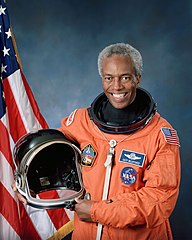West Palm Beach, Fla., May 17, 2013 — Two SECME coordinators, Kris Swanson from Poinciana Elementary, and Chris Perry from Atlantic High, and their two teammates have been selected by NASA to build an experiment that they will conduct with their students this spring, and then fly on NASA’s Microgravity Aircraft this summer.
Kris Swanson, Lisa Saunders, Vicki Spitalnick, and Jenn Andrews from Poinciana Elementary STEM (Science, Technology, Engineering and Math) Magnet School, and Chris Perry from Atlantic will spend ten days at the NASA Johnson Space Center in Houston, TX, this July to undergo training and learn more about microgravity and its effects on spacecraft and astronauts. At the end of the week, the teachers will take turns flying on the Microgravity trainer and conducting the experiment.
The experiment is titled “How Is Convection Affected By Microgravity?” It will utilize a small tank with heaters and coolers attached to it that will create a stable convection cell within it, and record the motion of the cell using video and temperature sensors. Students at Poinciana and Atlantic will run the experiment numerous times this spring in 1g, and hypothesize how convection may occur differently at 0g and 2g. This July, the teachers will repeat the student’s experiments in a reduced gravity aircraft, also known as the “Weightless Wonder.” Imagine the student’s excitement at their teachers floating for brief periods of weightlessness and microgravity.
Poinciana STEM Magnet school allows the students the opportunity to develop, create and hypothesize about hands-on experiments analyzing and sharing the results with other students to enhance the overall learning experience. The science program at Atlantic High is part of an International Baccalaureate magnet with a very strong emphasis on science, math, and technology. Students are not permitted to repeat the experiment on the reduced gravity flight themselves, but their teachers will bring back video and still pictures to help share their flight experiences as well as the matching data of 0g and 2g convection for the students to learn from.
Not only has this experience brought out the interest and curiosity of the students and teachers, but a group of engineers from several local companies and FAU have volunteered to assist with the coding, programming and building of the data recorder and the construction of the tank for the experiment. The engineers include Gabriel Goldstein from Anidea Engineering in Wellington, Ben Aiken, Adam Gresh, Ben Rigas, and Luis Moss from Modernizing Medicine in Boca Raton, Mahesh Neelakanta from FAU College of Engineering.
You can follow the team’s progress as they build the experiment, conduct it in 1g with their students, and fly it in microgravity this summer through their website
http://microgravity.poincianastem.org. The team is looking for sponsors to fund the building of their device and the travel expenses for the teachers’ trips to Houston this summer.
If you would like to contribute, checks can be made out to Poinciana Elementary School, 1203 N. Seacrest Blvd Boynton Beach, Fl 33435…. Memo Microgravity Team. Sponsors names and/or logos will be placed on the website and the banner which will fly in the “Weightless Wonder” aircraft this summer.
For more information, contact Lisa Lee at lisa.lee@palmbeachschools.org or call 561-739-5700.
About The School District of Palm Beach County
The School District of Palm Beach County is the eleventh largest in the nation and the fifth largest in the state of Florida with 185 schools, serving more than 177,000 students who speak 150 languages and dialects. As the largest employer in Palm Beach County, the School District has nearly 21,000 associates, including 12,627 teachers. To learn more about The School District of Palm Beach County, please visitwww.palmbeachschools.org.


 NASA Kennedy Space Center hosted a college recruitment fair for high school sophomores, juniors and seniors showcasing STEM education opportunities available at top colleges and universities across the nation.
NASA Kennedy Space Center hosted a college recruitment fair for high school sophomores, juniors and seniors showcasing STEM education opportunities available at top colleges and universities across the nation. The Air Force and its industry partners launched WGS-5, the fifth Wideband Global Satellite Communications spacecraft, into orbit aboard a United Launch Alliance Delta IV booster fired from Cape Canaveral AFS, Florida, at 8:27 p.m. Eastern on May 24.
The Air Force and its industry partners launched WGS-5, the fifth Wideband Global Satellite Communications spacecraft, into orbit aboard a United Launch Alliance Delta IV booster fired from Cape Canaveral AFS, Florida, at 8:27 p.m. Eastern on May 24.

 Moby and Lily Landstrom
Moby and Lily Landstrom Moby and Mr. Landstrom
Moby and Mr. Landstrom





